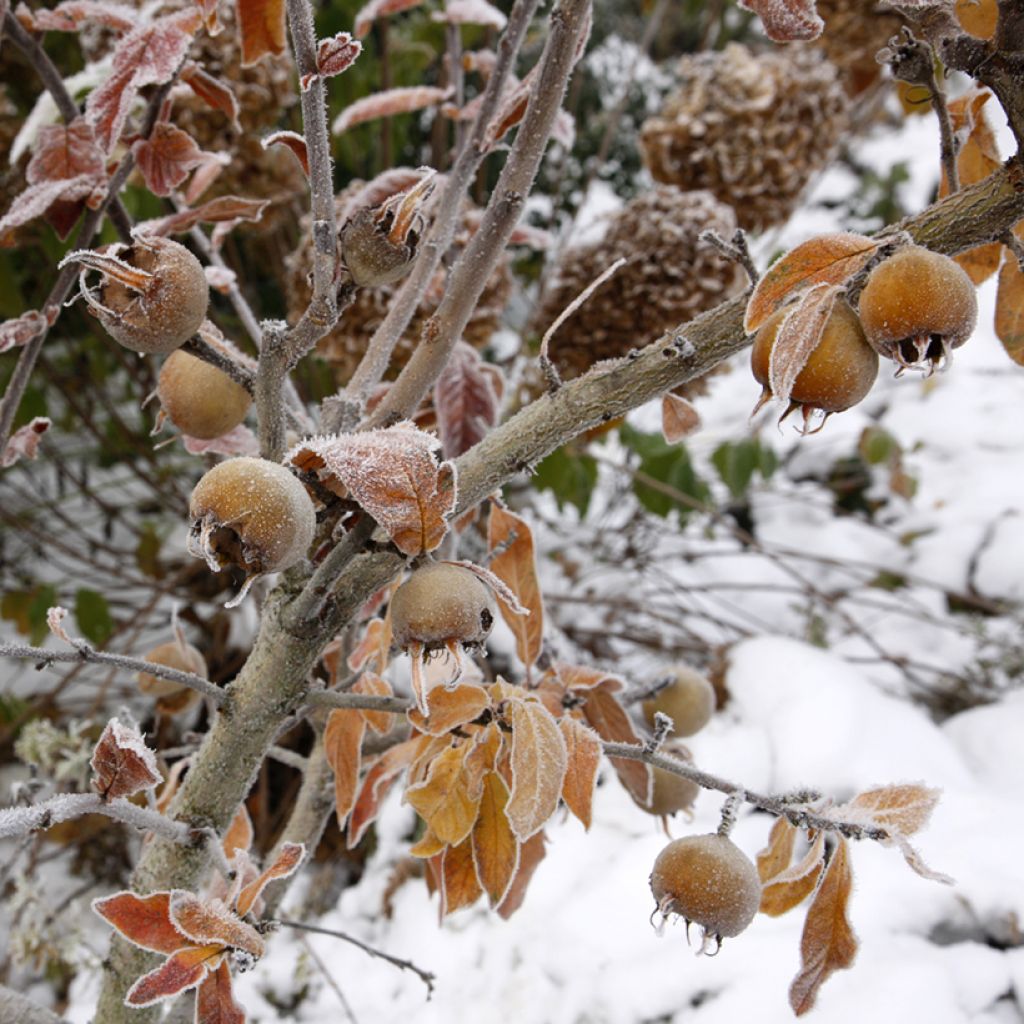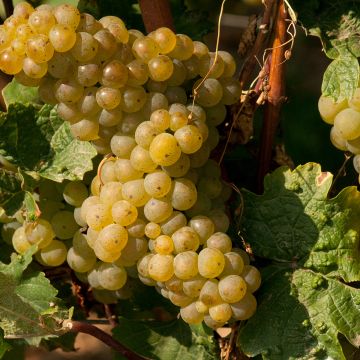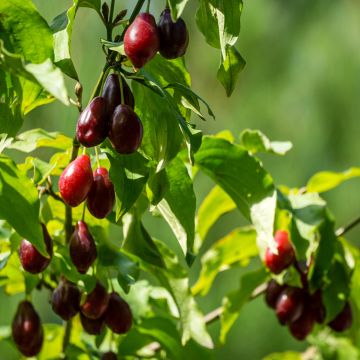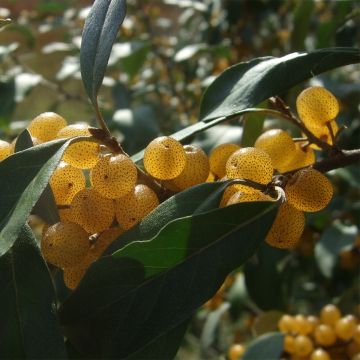

Medlar Macrocarpa - Mespilus germanica


Medlar Macrocarpa - Mespilus germanica


Medlar Macrocarpa - Mespilus germanica
Medlar Macrocarpa - Mespilus germanica
Mespilus germanica Macrocarpa
Medlar, Common Medlar
Special offer!
Receive a €20 voucher for any order over €90 (excluding delivery costs, credit notes, and plastic-free options)!
1- Add your favorite plants to your cart.
2- Once you have reached €90, confirm your order (you can even choose the delivery date!).
3- As soon as your order is shipped, you will receive an email containing your voucher code, valid for 3 months (90 days).
Your voucher is unique and can only be used once, for any order with a minimum value of €20, excluding delivery costs.
Can be combined with other current offers, non-divisible and non-refundable.
Why not try an alternative variety in stock?
View all →This plant carries a 24 months recovery warranty
More information
We guarantee the quality of our plants for a full growing cycle, and will replace at our expense any plant that fails to recover under normal climatic and planting conditions.
Would this plant suit my garden?
Set up your Plantfit profile →
Description
The Mespilus germanica 'Macrocarpa' is a variety of German Medlar with large fruits. This somewhat forgotten fruit bush produces large over-ripe medlars, which are consumed after they have been exposed to frost. Bigger than those of the wild species, the beautiful dark green leaves take on ornamental autumnal colours. This dark foliage also highlights the charming simple white flowering in spring. The brown fruits also have a certain decorative interest. Hardy, this old-fashioned fruit tree deserves to be rediscovered for its originality and ease of cultivation.
The Medlar belongs to the large family of Rosaceae, which includes most of our temperate climate fruit trees, many wild plants from our countryside and forests, and also a profusion of ornamental herbaceous or woody genera, such as Avens (Geum), Cotoneaster, and of course Roses (Rosa) which gave their name to the family. The Medlar, whose scientific name comes straight from ancient Greek mespilos, is a monospecific genus, even though there are hybrids obtained by cross-breeding with Hawthorns (Crataegus) called + Crataegomespilus (the + indicates that it is a chimera, a cross between two genera). Mespilus germanica is a shrub whose original range extends from Greece to the Caucasus region and Iran, and is found in France as well as in Central Europe, as it is quite hardy. It is scattered in hedges and woods, especially in sessile oak (Quercus petraea) stands in central and western France. The original wild species forms a shrub or small tree with twisted trunk and numerous thorny branches, but the cultivated forms since ancient times are generally inermous.
The 'Macrocarpa' variety (large fruit in Latin) is indeed distinguished by the size of its medlars. It forms a small tree, often grafted on a half-standard, with a fairly slow growth, especially in the first years, reaching up to 4 to 5 m in height and 3 to 4 m in width. In its shrubby form, it usually reaches a height and width of 3 m, with a spreading habit and a trunk divided into numerous low branches. The foliage consists of long elliptical leaves with pointed tips. Measuring from 12 to 15 cm long and 5 cm wide, the leaves have well-marked veins and a beautiful dark green colour. When autumn comes, they take on warm shades, ranging from yellow-orange to reddish-brown.
The dark foliage allows for a good appreciation of the beauty of the simple flowers, pure white, which bloom in May, delighting bees as they are melliferous. Composed of 5 rounded petals, the fully open corolla measures about 4 cm in diameter. The flowering is slightly fragrant and the plant being self-fertile, it develops into large fruits reaching 5 cm in diameter or more (compared to 3 to 4 cm for the botanical species). Spherical, they resemble small apples and turn from greenish-gray to reddish-brown when ripe, around October-November. Inedible at first due to their very tart flesh, they need to be exposed to frost for their composition to change and for our palate to accept them. They are left to soften for 3 weeks to 2 months, for example by placing them on a bed of straw in a cool and airy place. Rich in tannins, mucilage, and fat, medlars also contain citric, malic, and caratric acids. Astringent, they were used in the past to treat diarrhoea, and the leaves, after decoction, were used to combat aphthae and sore throat. In cooking, the fruits go perfectly with game.
The Mespilus germanica 'Macrocarpa' deserves to regain its place in our gardens. Very hardy and easy to grow, its unusual fruits bring originality to our diet. Aesthetically, it also has true ornamental value and will find its place in an untrimmed hedge, in a varied flower bed, or in a small orchard inspired by the past. You can accompany it with other extraordinary fruit trees such as the Amelanchier 'Ballerina' with its delicious red fruits in autumn. Its foliage, tinged with copper in spring, takes on a sumptuous red, orange, and purple colour in autumn. The Sorbus 'Grananatnaja', resulting from the cross between a Sorbus and a Hawthorn, produces clusters of small dark red fruits with tart yellow flesh. It also displays beautiful autumn colours. And why not a Quince tree, like the Cydonia oblonga 'Vranja', whose pretty yellow fruits can be cooked to make jam, compotes, or crumbles...
Medlar Macrocarpa - Mespilus germanica in pictures


Plant habit
Flowering
Foliage
Botanical data
Mespilus
germanica
Macrocarpa
Rosaceae
Medlar, Common Medlar
Crataegus germanica 'Macrocarpa'
Cultivar or hybrid
Other Fruit trees A to Z
View all →Planting and care
Plant your Mespilus germanica 'Macrocarpa' preferably in full sun or under light shade. It accepts a wide variety of soils, from acidic (pH 6) to limestone, only fearing excess clay or limestone. It prefers light and permeable humus-bearing soils, but can adapt to less favourable conditions. Very cold-resistant, up to approximately -25°C, this plant acclimates quite well in the Mediterranean region, provided it is watered in summer. Similarly, after planting, it will be necessary to water regularly for the first two years to help it establish a good root system.
Although quite resistant, the Medlar can be attacked by some diseases such as powdery mildew or brown rot, as well as the dreaded fire blight caused by a bacterium for which there is no treatment. Also watch out for potential attacks from insects, aphids or scale insects, as well as the Mediterranean fruit fly.
Planting period
Intended location
Care
Planting & care advice
This item has not been reviewed yet - be the first to leave a review about it.
Similar products
Haven't found what you were looking for?
Hardiness is the lowest winter temperature a plant can endure without suffering serious damage or even dying. However, hardiness is affected by location (a sheltered area, such as a patio), protection (winter cover) and soil type (hardiness is improved by well-drained soil).

Photo Sharing Terms & Conditions
In order to encourage gardeners to interact and share their experiences, Promesse de fleurs offers various media enabling content to be uploaded onto its Site - in particular via the ‘Photo sharing’ module.
The User agrees to refrain from:
- Posting any content that is illegal, prejudicial, insulting, racist, inciteful to hatred, revisionist, contrary to public decency, that infringes on privacy or on the privacy rights of third parties, in particular the publicity rights of persons and goods, intellectual property rights, or the right to privacy.
- Submitting content on behalf of a third party;
- Impersonate the identity of a third party and/or publish any personal information about a third party;
In general, the User undertakes to refrain from any unethical behaviour.
All Content (in particular text, comments, files, images, photos, videos, creative works, etc.), which may be subject to property or intellectual property rights, image or other private rights, shall remain the property of the User, subject to the limited rights granted by the terms of the licence granted by Promesse de fleurs as stated below. Users are at liberty to publish or not to publish such Content on the Site, notably via the ‘Photo Sharing’ facility, and accept that this Content shall be made public and freely accessible, notably on the Internet.
Users further acknowledge, undertake to have ,and guarantee that they hold all necessary rights and permissions to publish such material on the Site, in particular with regard to the legislation in force pertaining to any privacy, property, intellectual property, image, or contractual rights, or rights of any other nature. By publishing such Content on the Site, Users acknowledge accepting full liability as publishers of the Content within the meaning of the law, and grant Promesse de fleurs, free of charge, an inclusive, worldwide licence for the said Content for the entire duration of its publication, including all reproduction, representation, up/downloading, displaying, performing, transmission, and storage rights.
Users also grant permission for their name to be linked to the Content and accept that this link may not always be made available.
By engaging in posting material, Users consent to their Content becoming automatically accessible on the Internet, in particular on other sites and/or blogs and/or web pages of the Promesse de fleurs site, including in particular social pages and the Promesse de fleurs catalogue.
Users may secure the removal of entrusted content free of charge by issuing a simple request via our contact form.
The flowering period indicated on our website applies to countries and regions located in USDA zone 8 (France, the United Kingdom, Ireland, the Netherlands, etc.)
It will vary according to where you live:
- In zones 9 to 10 (Italy, Spain, Greece, etc.), flowering will occur about 2 to 4 weeks earlier.
- In zones 6 to 7 (Germany, Poland, Slovenia, and lower mountainous regions), flowering will be delayed by 2 to 3 weeks.
- In zone 5 (Central Europe, Scandinavia), blooming will be delayed by 3 to 5 weeks.
In temperate climates, pruning of spring-flowering shrubs (forsythia, spireas, etc.) should be done just after flowering.
Pruning of summer-flowering shrubs (Indian Lilac, Perovskia, etc.) can be done in winter or spring.
In cold regions as well as with frost-sensitive plants, avoid pruning too early when severe frosts may still occur.
The planting period indicated on our website applies to countries and regions located in USDA zone 8 (France, United Kingdom, Ireland, Netherlands).
It will vary according to where you live:
- In Mediterranean zones (Marseille, Madrid, Milan, etc.), autumn and winter are the best planting periods.
- In continental zones (Strasbourg, Munich, Vienna, etc.), delay planting by 2 to 3 weeks in spring and bring it forward by 2 to 4 weeks in autumn.
- In mountainous regions (the Alps, Pyrenees, Carpathians, etc.), it is best to plant in late spring (May-June) or late summer (August-September).
The harvesting period indicated on our website applies to countries and regions in USDA zone 8 (France, England, Ireland, the Netherlands).
In colder areas (Scandinavia, Poland, Austria...) fruit and vegetable harvests are likely to be delayed by 3-4 weeks.
In warmer areas (Italy, Spain, Greece, etc.), harvesting will probably take place earlier, depending on weather conditions.
The sowing periods indicated on our website apply to countries and regions within USDA Zone 8 (France, UK, Ireland, Netherlands).
In colder areas (Scandinavia, Poland, Austria...), delay any outdoor sowing by 3-4 weeks, or sow under glass.
In warmer climes (Italy, Spain, Greece, etc.), bring outdoor sowing forward by a few weeks.





































































